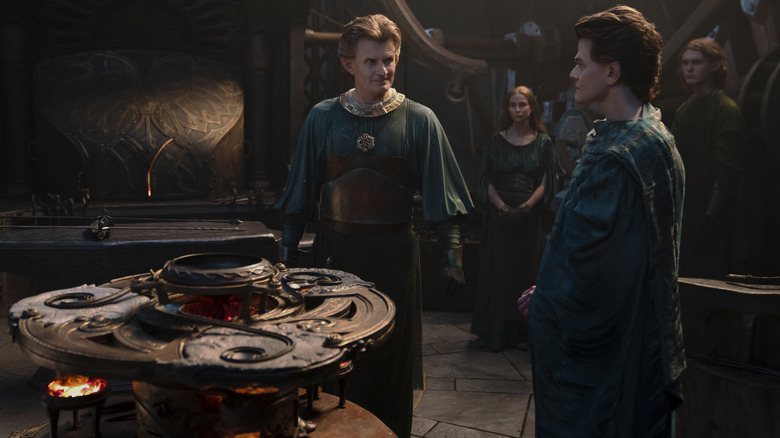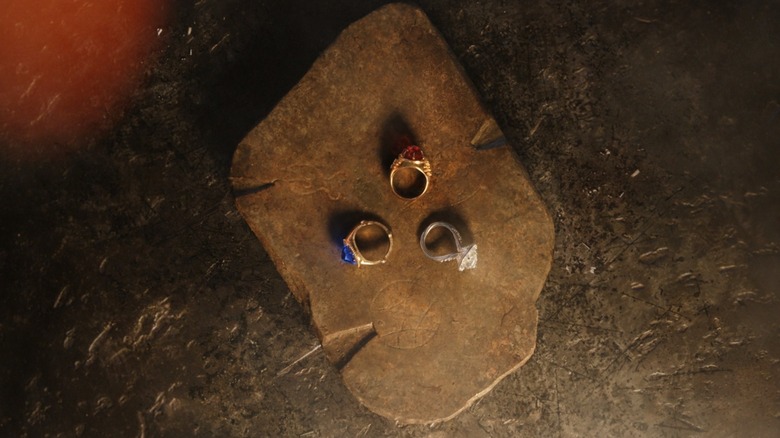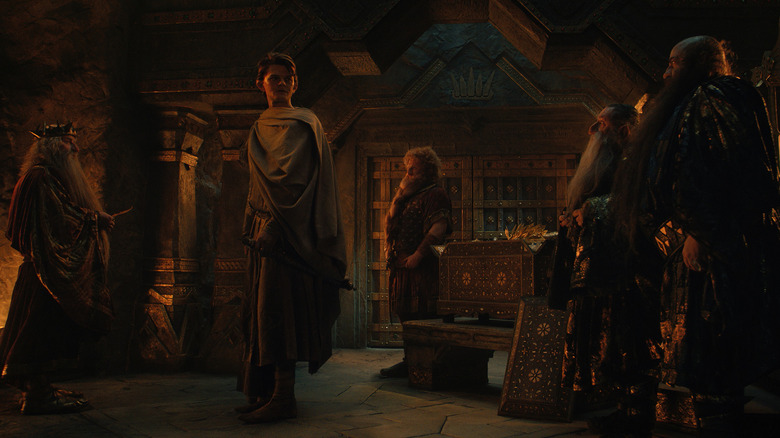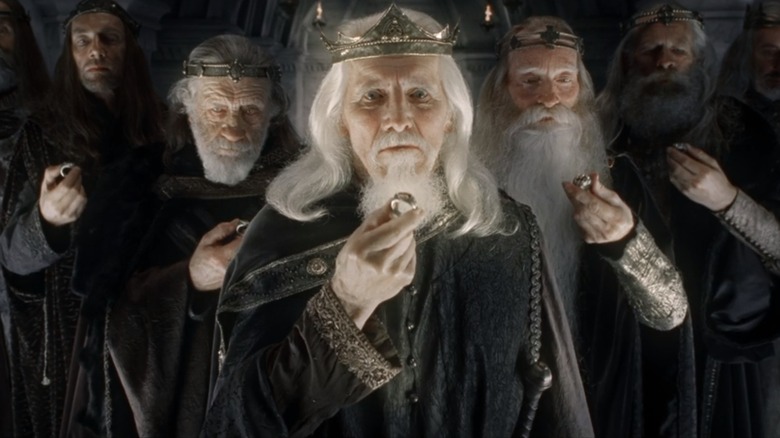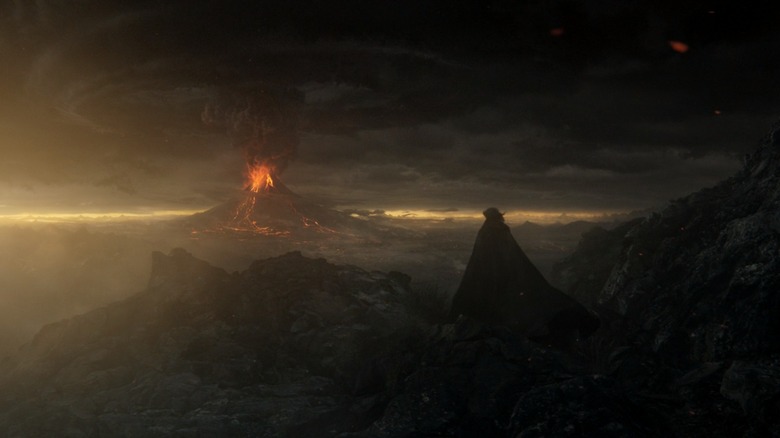Breaking Down All The Rings Of Power From Amazon's Lord Of The Rings Series
"One Ring to rule them all ..."
Fans aren't likely to forget the haunting words narrated by Cate Blanchett's elf queen Galadriel which open 2001's "The Lord of the Rings: The Fellowship of the Ring," adapted from author J.R.R. Tolkien's original text. In short order, director Peter Jackson had summed up much of the backstory that newcomers would need to hit the ground running and understand the plight of Middle-earth under the threat of the Dark Lord Sauron's return. But as much as the trilogy relied upon the fate of the One Ring, it mostly left all those other Rings of Power strictly on the sidelines.
That's where Prime Video's "The Lord of the Rings: The Rings of Power" series came in, filling in the gaps from thousands of years earlier in the canon to tell the sprawling tale of how the heroes of Middle-earth dealt with Sauron the last time he appeared. As of the season 1 finale, the series will also deal with the creation of the first of those Rings.
Although liberties were taken regarding plot specifics, like a younger Galadriel (played by Morfyyd Clark) obsessively following the trail of Sauron or the existence of Charlie Vickers' duplicitous Halbrand, the broad strokes remain in line with the accounts laid down by Tolkien in the appendices found at the end of "The Return of the King." As implied by the title, the debut season carefully documented the series of events that would eventually motivate Galadriel, her loyal friend Elrond (Robert Aramayo), and the great elven craftsman Celebrimbor (Charles Edwards) to combine their various powers into crafting three particular rings.
But what is their significance? How many more are there still to be made? How do they tie into Sauron's grand plan? Let's dive in and find out.
'Three Rings for the Elven-kings under the sky ...'
In Tolkien's various stories and notes, the forging of the three rings for the elves comes about slightly differently than depicted in "The Rings of Power" — though plenty of parallels remain. At this point in history, Sauron has disguised himself under the "fair" and unassuming visage of Annatar, an elvish name meaning "Lord of Gifts," which explains the cheeky emphasis of that word in the season finale. Although that alias hasn't yet been spoken aloud in the Prime Video series, it's clear that this is meant to be the show's interpretation of the same events.
According to Tolkien, Sauron emerges from centuries of hiding in the wake of Morgoth's defeat during the First Age (for context, "The Rings of Power" is set during the Second Age) and befriends the great elven smiths of Eregion — including the greatest of them all, Celebrimbor. Despite the concerns of certain elves like Galadriel and Elrond, Annatar passes on his expert knowledge of ring-making and the ability to imbue their wearers with the power to transform Middle-earth with healing, preservation, and protection. However, as with the series, it's important that Sauron isn't directly involved in the crafting of the three major elvish rings. Whereas Tolkien describes Celebrimbor as crafting the three only after Annatar departs the region, "The Rings of Power" ties Galadriel's realization of Halbrand's true identity as Sauron into his hasty departure before the rings could be finished. Upon completion, Galadriel, Elrond, and Celebrimbor should now be able to stave off the diminishing power of their people.
Their unique origin in "The Rings of Power" also extends to the order of their creation. In the books, the elvish rings are created last of all the rings of power. Here, they're crafted first.
'Seven for the Dwarf-lords in their halls of stone ...'
That brings us to the mighty dwarves, whom we've seen throughout "The Rings of Power" season 1 through the eyes of Elrond's old friend, Prince Durin (Owain Arthur). In the series, they've yet to receive their own batch of seven rings gifted by Annatar to seven different great lords. Unlike the elven rings, however, these are crafted under Sauron's supervision and explicitly meant to corrupt whoever wears them. But Annatar underestimates the hardiness of dwarves, who seem impervious — on the surface, at least — to their power. Yet that doesn't mean they wield no influence whatsoever, as they exacerbate their lust for gold and riches (this, shall we say, isn't one of Tolkien's finer moments in terms of reinforcing questionable stereotypes) and even contain the power to exponentially increase the precious ore they mine.
While Sauron's grand plan involves collecting all the rings under his power, he finds this particularly difficult with the dwarves. By the time "The Lord of the Rings" begins, most of the dwarven rings have either been consumed by dragons or simply lost in the intervening ages. Only two ultimately make it back into his clutches, one of which belonged to the father of Thorin Oakenshield (portrayed by Richard Armitage in Jackson's "The Hobbit").
It's hard to know exactly how season 2 will depict Sauron's treachery with the dwarves, especially since the secret is now out, and none ought to trust Halbrand again. Will Sauron find another disguise, leading to yet another season-long guessing game as to who he might be this time around? Or, famously stubborn as they are, will Durin's father and people simply ignore Galadriel's warnings and trust Halbrand anyway, accepting his favor and dooming themselves to centuries of trouble?
'Nine for mortal men doomed to die ...'
And now we come to some of the most famous rings of them all (excepting the One Ring, of course). Tolkien, Jackson's "The Lord of the Rings," and "The Rings of Power" have all taken pains to portray the race of men as the most susceptible to evil of all the peoples of Middle-earth. This is proven most emphatically through what's believed to be the Númenórean lords who were most easily seduced by Annatar. Similar to the dwarven rings, these helped their bearers achieve great wealth and power ... but like the One Ring itself, they also unnaturally extended their lifespans until they eventually withered away into invisibility and fell under Sauron's sway entirely. Known henceforth as Ringwraiths, they would eventually plague our fellowship of heroes on their quest to destroy the One Ring thousands of years later, but that's getting ahead of ourselves.
Excitingly, it's possible that we'll soon be introduced to the flawed figureheads whom Sauron will bestow his gifts upon in future seasons of "The Rings of Power." Having already established the island kingdom of Númenor, the series should have no trouble at all introducing these more sinister individuals in stark juxtaposition to other supporting characters, such as the noble Elendil (Lloyd Owen). The table-setting has already begun, evidenced by the impending fall of Númenór due to their leaders' profound fear of death. What better way to exploit this weakness than by offering some rings of power that can prolong life indefinitely?
Although all of these events take place over the course of hundreds of years in Tolkien's writings, "The Rings of Power" will have to continue to drastically condense its timeline for adaptation purposes. Either way, expect some major events in season 2.
'One for the Dark Lord on his dark throne ...'
And, of course, we can't forget the One Ring to rule them all. By far the biggest development in season 1 of "The Rings of Power" has to be the Halbrand/Sauron reveal dovetailing with the transformation of the Southlands into the land of Mordor, where the shadows lie. While fans can consider the eruption of Mount Doom and its subsequent terraforming of the surrounding area as a sort of Easter egg further connecting the series to the events of "The Lord of the Rings," it actually serves an incredibly important practical purpose, as well.
As part of Sauron's devious scheme, all the 19 total rings of power (known as the "lesser rings") are meant to come under the control of his secret One Ring, created with the express purpose of turning all of Middle-earth's most powerful people into his puppets. But in order to craft the most powerful object the world has ever seen (at least since the Silmarils, that is), Sauron would need a forge to match. No dark magic in all the land could compete with Mount Doom itself, the beating black heart of the evil land, and the location where the One Ring was forged.
You might remember a little trilogy of movies called "The Lord of the Rings" that depicted why this ring was so important in the first place. But long before, Sauron's scheme paid off as the rings allowed him to wage open war on all of Middle-earth. "The Rings of Power" has some time to go before plunging into this conflict to come, but the seeds have been planted and now we await the forging of the other rings of power.
"The Rings of Power" season 2 comes to Prime Video sometime in 2024.
